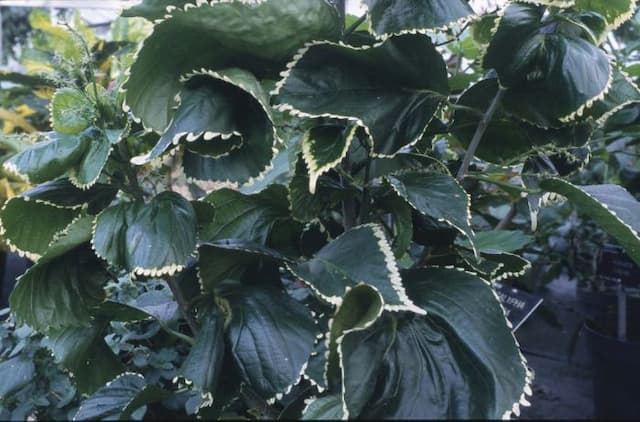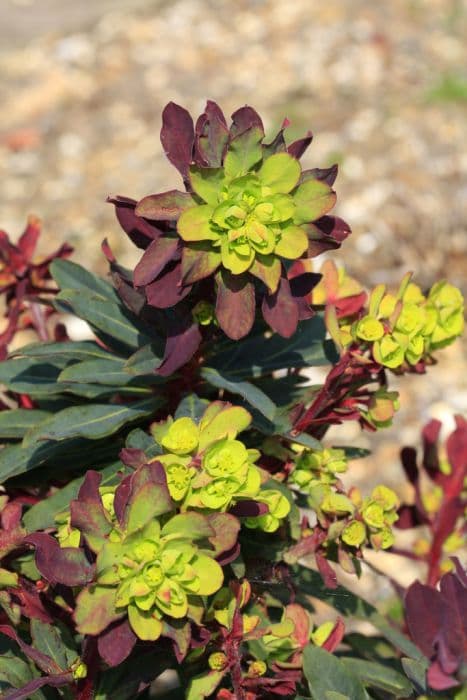Spurge Euphorbia × pasteurii 'John Phillips'

ABOUT
Euphoria 'John Phillips' is an attractive ornamental plant known for its striking foliage and intriguing flowering structures. The plant displays a bushy, evergreen habit, featuring leaves that are medium green in color and often take on a reddish hue in cooler temperatures. These leaves typically have a smooth, elongated oval shape with pointed tips and are arranged in a dense, compact fashion along the stems, lending the plant a lush, full appearance. One of the most distinctive features of Euphoria 'John Phillips' is its flowers, which are not like typical flowers but instead are specialized structures called cyathia. They appear in clusters and are characterized by small, yellowish bracts that look like petals surrounding a central hub that contains the actual tiny flowers. The effect is a subtle yet eye-catching display that adds a unique textural and color contrast to the foliage. The overall impression of Euphoria 'John Phillips' is that of a well-formed, robust plant that stands out in garden settings and landscapes due to its year-round visual interest and its adaptability to various planting schemes. Its evergreen nature makes it an excellent choice for gardeners wanting to maintain greenery throughout different seasons.
About this plant
 Names
NamesFamily
Euphorbiaceae
Synonyms
Spurge
Common names
Euphorbia × pasteurii 'John Phillips'.
 Toxicity
ToxicityTo humans
Spurge (Euphorbia) contains a white, milky sap known as latex that can be toxic if ingested and can cause irritation upon contact with the skin or eyes. If the sap is ingested, it can cause symptoms such as burning pain in the mouth and throat, nausea, vomiting, and diarrhea. In severe cases, it may lead to more serious symptoms such as swelling of the eyes, mouth, and tongue, difficulty swallowing, and even temporary vision impairment if eye contact occurs. It is important to handle spurge with care and wash your hands thoroughly after touching it to avoid accidental ingestion or contact with sensitive areas of the body.
To pets
Spurge is also toxic to pets due to the milky latex sap it contains. If a pet ingests the plant, it can cause symptoms similar to those in humans, including irritation of the mouth and stomach, drooling, vomiting, and diarrhea. In severe cases, ingestion of the plant sap may result in more serious health issues such as intense gastrointestinal upset, and dehydration from vomiting and diarrhea. Pets should be kept away from spurge, and any exposure should be treated as a potential veterinary emergency.
 Characteristics
CharacteristicsLife cycle
Perennials
Foliage type
Evergreen
Color of leaves
Green
Flower color
Yellow
Height
4 feet (1.22 meters)
Spread
3 feet (0.91 meters)
Plant type
Shrub
Hardiness zones
7
Native area
Hybrid
Benefits
 General Benefits
General Benefits- Low Maintenance: Euphorbia × pasteurii 'John Phillips' requires minimal care once established, making it an easy choice for gardeners with limited time.
- Drought Tolerant: Once established, it is highly tolerant of drought, reducing the need for frequent watering.
- Attractive Foliage: It has attractive foliage that provides visual interest throughout the growing season.
- Long Blooming: Produces flowers over a long period, typically from spring to fall, offering extended visual appeal.
- Pest Resistant: It is resistant to many common pests, which can reduce the need for chemical treatments.
- Deer Resistant: Its sap and texture make it less appealing to deer, which can help protect the garden from browsing damage.
- Erosion Control: It can help prevent soil erosion thanks to its robust root system, especially when planted on slopes or in areas with loose soil.
- Architectural Interest: This plant has a strong shape and structure, providing architectural interest in the garden or landscape.
- Mixed Borders: It works well in mixed borders, complementing a wide variety of other plants.
- Winter Interest: Some varieties retain their shape and seed-heads in winter, adding interest to the winter garden.
 Medical Properties
Medical PropertiesThis plant is not used for medical purposes.
 Air-purifying Qualities
Air-purifying QualitiesThis plant is not specifically known for air purifying qualities.
 Other Uses
Other Uses- Euphorbia × pasteurii 'John Phillips', commonly known as Spurge, can be used as a natural insect repellent due to its sap, which many insects find irritating.
- Spurge can be planted as a protective barrier around vegetable gardens to deter certain pests and animals because of its toxic and irritating sap.
- This plant's dense foliage can provide shelter and nesting sites for small garden wildlife, such as beneficial insects and birds.
- Spurge can be used in dried flower arrangements for decorative purposes because of its unique texture and form, especially in modern or rustic designs.
- The sturdy stems of Spurge can be used as natural stakes or supports for other less stable plants in the garden.
- When planted on slopes or banks, Spurge can act as an erosion control agent due to its extensive root system.
- The sap of Spurge has been used traditionally to make a natural latex substance, although it is not a common practice and can be risky due to the sap’s irritant properties.
- During seasonal festivities, Spurge can be incorporated into wreaths and other decorations for a touch of greenery.
- The unique and striking appearance of Spurge can be used as a photography subject or as inspiration in botanical illustration and art.
- Spurge can play a role in education and conservation by being a part of botanical gardens and ecological demonstrations showing the diversity of plant life.
Interesting Facts
 Feng Shui
Feng ShuiThe Spurge is not used in Feng Shui practice.
 Zodiac Sign Compitability
Zodiac Sign CompitabilityThe Spurge is not used in astrology practice.
 Plant Symbolism
Plant Symbolism- Healing and Protection: Euphorbias, known commonly as Spurge, often exude a milky sap that has been used in traditional medicine. Thus, they are commonly associated with healing. Additionally, the toxicity of some Euphorbias has given them a reputation for protection, as they deter pests and herbivores.
- Persistence and Resilience: Spurge is known for its ability to thrive in challenging conditions where other plants might struggle. It symbolizes the ability to persist and adapt to different environments.
- Transformation: Euphorbia 'John Phillips' is a hybrid plant, representing the creation of something new and beautiful through the combination of diverse elements. This could symbolize personal growth or transformation.
 Water
WaterSpurge, including the Euphorbia × pasteurii 'John Phillips', requires moderate watering with a focus on allowing the soil to dry out between watering intervals to prevent root rot. It is best to water this plant thoroughly, ensuring the root zone is moistened, and then wait for the top inch of soil to dry out before watering again. Depending on the climate and indoor conditions, this will likely mean watering every 7 to 10 days. A good practice is to provide approximately one gallon for larger plants during each watering session, adjusting for the size of the plant and the pot.
 Light
LightSpurge prefers full sun to partial shade, making it well-suited for a spot that gets at least 4-6 hours of direct sunlight daily. The best location would be one where the plant is exposed to the morning sun and shaded during the hottest part of the afternoon, especially in areas with very high temperatures.
 Temperature
TemperatureSpurge thrives in temperatures between 50 and 75 degrees Fahrenheit, but the plant can survive in temperatures as low as 30 degrees Fahrenheit and as high as 90 degrees Fahrenheit. However, prolonged exposure to temperatures outside the ideal range can stress the plant.
 Pruning
PruningSpurge may require pruning to remove any damaged or diseased foliage and to maintain its shape. The best time to prune is in the late winter or early spring before new growth begins. Pruning can be done annually, and it's important to wear gloves as the sap can be an irritant.
 Cleaning
CleaningAs needed
 Soil
SoilEuphorbia × pasteurii 'John Phillips', commonly known as spurge, thrives in a well-draining soil mix with a slightly acidic to neutral pH between 6.0 and 7.5. A mixture containing two parts loam, one part sand or perlite, and one part peat or compost is ideal for maintaining good drainage and aeration, which are crucial for the health of the roots and prevention of rot.
 Repotting
RepottingSpurge should be repotted every two to three years to refresh the soil and accommodate root growth. It's best to repot in spring or early summer when the plant is in active growth. Ensure the new pot is only slightly larger than the old one to prevent water retention which can lead to root rot.
 Humidity & Misting
Humidity & MistingSpurge, prefers moderate humidity levels but is quite adaptable and can tolerate the dry air typically found in homes. There's no need to provide any extra humidity for this resilient plant.
 Suitable locations
Suitable locationsIndoor
Provide bright, indirect light and room to grow.
Outdoor
Plant in partial sun, shelter from extreme weather.
Hardiness zone
7-11 USDA
 Life cycle
Life cycleThe Euphorbia × pasteurii 'John Phillips', commonly known as Spurge, starts its life cycle as a seed, dispersing from the parent plant to germinate in suitable growing conditions. Upon germination, a seedling emerges and establishes itself, developing a root system and a rosette of foliage. As it matures into a vegetative plant, the Spurge develops a branched structure and produces characteristic leaves and stems, with a milky sap that is typical of Euphorbia species. The plant then reaches a reproductive stage, where it produces clusters of small, inconspicuous flowers, typically enveloped by showy, colorful bracts that attract pollinators. After pollination, fruits in the form of capsules develop that eventually burst to release seeds, completing the life cycle. Throughout multiple seasons, this perennial plant will experience periods of growth and dormancy, adjusting to seasonal changes, and may live for several years.
 Propogation
PropogationPropogation time
Spring-Early Summer
Euphorbia × pasteurii 'John Phillips', commonly known as Spurge, is commonly propagated through cuttings. The best time to take cuttings for propagation is in late spring to early summer when the plant's growth is most active. To propagate Spurge, a gardener should select a healthy stem and cut a 3- to 4-inch (7.5 to 10 cm) length just below a leaf node, where the concentration of hormones will be higher. The cutting end should then be allowed to dry and callous over for a day or two to prevent rotting when planted. The calloused cutting is then inserted into a well-draining soil mix. Care should be taken to keep the soil consistently moist but not waterlogged until the cutting has taken root, which typically takes a few weeks. Once roots have established, the new Spurge plant can be gradually introduced to more direct sunlight and less frequent watering.



![Spurge [Blackbird]](/_next/image?url=https%3A%2F%2Fplants-admin.emdemapps.com%2Fimages%2Fplants%2F%2Fimages%2F604b535f37783.png&w=640&q=75)





